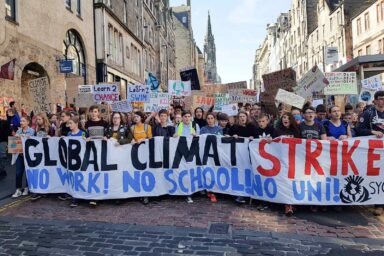Editors’ Picks: Special Uprising Edition
Officials in Minneapolis Call for ‘Disbanding’ of Police ; ‘If You Do Not Move, You Will Be Dead’ ; and More Picks
A roundup of reporting, commentary, and analysis related to the recent international demonstrations against racism and police brutality.
Amid 12 days unlike any other in US history — beginning on May 25, when George Floyd died under the knee of former Minneapolis police officer Derek Chauvin — even the most news-conscious Americans have reported feeling unable to keep up with coverage of coast-to-coast protests and incidents.
WhoWhatWhy editors have compiled a broad sampling of not only stories readers may have missed, but also thought-provoking social media posts and opinion pieces on the events. We have included day-by-day summaries with links to the extraordinary reporting of the past week, followed by a selection of notable commentary and analysis. [Note: We have not updated these summaries with later developments.]
Friday, June 5
As the unrest of the week settled, responses from the media, government, and nonprofits were varied.
The Minneapolis Police Department chose Friday to announce a ban on chokeholds; a leaked document revealed that the Trump administration had deployed military and federal law enforcement personnel in Washington, DC; law enforcement seized protective masks labeled “Stop Killing Black People”; executives at the New York Times took turns apologizing to the newspaper’s staff for publishing a column by US Sen. Tom Cotton (R-AZ) titled “Send in the Troops”; and, due in part to the efforts of nonprofit voter registration organizations, some started predicting that the surge in voter registration since Floyd’s murder could shift the result of the November presidential election.
Twitter saw more citizen reporting than usual. One tweeted video in particular caught some WhoWhatWhy editors’ attention — that of a Texas man brandishing a chainsaw and screaming obscenities and racial slurs at a crowd of retreating protesters.
Thursday, June 4
Twitter was aflame with both outrage and hope on Thursday. A tweet of protesters setting fire to a police vehicle in Guadalajara, Mexico, provided evidence of the international spread of anger. In the US, Philadelphia protesters captured a video of bicycle police beating protesters with clubs, and one Twitter user expressed pride over a younger sister’s marching across the Brooklyn Bridge in her first protest ever.
News reports included coverage of UCLA Chancellor Gene Block stating that the Los Angeles Police Department’s use of Jackie Robinson Stadium to process arrested protesters violated UCLA values and that the university will “do better”; teens leading protests in Nashville, TN; and the New York State Supreme Court ruling that protesters can be indefinitely detained.
https://twitter.com/secretlaith/status/1268251322467450880
Wednesday, June 3
Philadelphia was beset with violence (and mystery) mid-week. Police and federal officials are investigating 135 alleged ATM explosions caused by illegal devices; charges were filed against a 26-year-old man from Frankford, PA, for attempting to sell homemade dynamite. Meanwhile, a Temple University engineering student, arrested and accused of assaulting a police officer, had charges against him dismissed when YouTube and Twitter videos showed that he’d been beaten with a baton after attempting to separate a police officer and a peaceful protester. The officer involved has been removed from street duty.
Reports of disturbing police incidents in other cities showed New Orleans police tossing tear gas into a peaceful crowd; uniformed officers shooting rubber bullets into a nonviolent crowd of protesters in Washington, DC; and Louisville, KY, police shooting at vehicles stuck in traffic. The person who tweeted the Louisville incident commented, “Reminder: the police are rioting.”
The White House tweeted and then within two hours removed propaganda videos alleging that an antifa (anti-fascist) group was handing bricks to “rioters” during nationwide protests.
Tuesday, June 2
Tuesday saw many reports of violence — physical and verbal — both by and against police.
In Asheville, NC, police officers “aggressively dismantled” a medic station near a protest, causing the mayor and medical staff to question the department’s strategy. A video on Twitter showed the driver of a military vehicle in Walnut Creek, CA, shouting at peaceful protesters, “If you do not move, you will be dead.” Other disturbing videos showed a young girl screaming in pain after allegedly being maced by a Seattle police officer.
A police officer was on life support at University Medical Center in Las Vegas, NV, after protests there turned violent. The Las Vegas Metropolitan Police Sheriff said that the officer was shot while attempting to clear protesters from Las Vegas Boulevard. Violence during a protest in St. Louis, MO, left four officers with non-life-threatening injuries; Police Chief John Hayden called the perpetrators “cowardly individuals.”
President Trump’s visits to Christian churches and shrines resulted in condemnation from church leaders for “using holy spaces as political props.”
Meanwhile, in Paris, rioters employed e-scooters to create flaming barricades. And in Minneapolis, city council members opened discussions about potentially disbanding city police.
Mount Pleasant, DC has had an hour-long pot banging session post-curfew and it’s only getting louder pic.twitter.com/06nX95u4kQ
— Ishaan Tharoor (@ishaantharoor) June 3, 2020
Monday, June 1
K-pop fans are known to target celebrities, but this week have taken on the police. In Dallas, police were using apps and online portals for videos of protesters when K-pop fans flooded them with fancams — videos of their favorite singers performing.
Two 19-year-olds from Oakland, CA, inspired a protest of more than 15,000 people with an Instagram post expressing their dismay at police brutality against blacks. Young people in attendance provided masks and hand sanitizers to protesters.
In Van Nuys, CA, owners protecting their shop were mistaken by police as looters — while Fox captured it on video.
Protesters trapped between police and a high metal fence were tear-gassed in Philadelphia; and MSNBC captured live footage in Seattle as police tear-gassed demonstrators there. Chaos ensued in Naperville, IL, outside Chicago, after a curfew was imposed; a state of emergency was announced as two protesters were killed and many were injured — the violence and looting led to 60 arrests.
https://twitter.com/kellianderson/status/1268591985788694530?s=20
Sunday, May 31
US Attorney General William Barr announced that federal agencies would be deploying personnel to “support local efforts to enforce federal law,” describing the protests as “domestic terrorism.” Meanwhile, BuzzFeed reported obtaining a two-page memorandum from the Drug Enforcement Administration announcing their authority to investigate and “conduct covert surveillance” of people participating in protests.
Looting reached new heights in San Leandro, CA, with reports of at least 70 cars being stolen from a single Dodge dealership. Meanwhile, a Fox reporter interviewed youths in Santa Monica while broadcasting from the scene of a looting there.
New York City Mayor Bill de Blasio’s daughter, Chiara de Blasio, was arrested with about 100 other people who refused to clear the intersection of Broadway and 12th Street in Manhattan.
Saturday, May 30
YouTube videos of tear-gassed protesters in Raleigh, NC, provided evidence of how law enforcement handled the outpouring there of anger and dismay at George Floyd’s killing. Video of the Los Angeles Police Department’s use of batons on peaceful protesters made ABC local news. And peaceful protester Sarah Grossman was killed by tear gas in Columbus, OH.
Despite reports of “outsiders” causing violence and looting in Minneapolis and St. Paul, local jail records showed that the vast majority of arrests were of local and Minnesota residents.

PICKS
The author writes, “It is time … to be unafraid to speak a clear truth: Whether by design or lack of it, Donald Trump and the Republican Party operate an American state that they have increasingly organized on fascist principles. It is also time [to] consider what else the fascists may yet do, during an unprecedented pandemic, amid unprecedented unemployment, faced with unprecedented resistance ahead of an unprecedented election. … With federal border patrol and FBI agents involved, there could be neighborhood cordons, warrantless surveillance and raids, mass roundups, tortures, and extrajudicial killings. Of course, the United States has already done most of these in recent years, and federal officials have lied about virtually all of it. But these have been explorations and interludes compared to what can follow, in the leadup to the November election and in its aftermath.”
Proportionate Response: When Destroying a Police Precinct Is a Reasonable Reaction (Chris C.)
The author writes, “The order the police protect and sustain is an order in which needed resources remain in the hands of the few. Whether or not they are actually killing or beating somebody, police are always threatening the use of lethal violence (mostly at the poor, disproportionately at Black and other nonwhite people) … There should be absolutely no confusion about the logic of destroying a police station in response to the police killing of George Floyd. You can agree with or disagree with the action. But you cannot deny that there is a logic in targeting a police station after the police have lynched a man in broad daylight, on video. It’s an attempt to create a different order in the society. … The uprising we’ve seen this week is speaking to the American police state in its own language, up to and including the use of fireworks to mark a battle victory. Property destruction for social change is as American as the Boston Tea Party and the Stonewall Riots.”
We Must Disband the Police — Here’s What Could Come Next (DonkeyHotey)
From Time: “When I ran for the Minneapolis City Council in 2017, I knew that the Police Department had a decades-long history of violence and discrimination. I ran on a platform of police reform … Most of us who are currently in office in Minneapolis ran on a platform that included police reform and accountability. Many elected leaders before us have tried and failed to achieve meaningful progress on those fronts, and for the first two years of our current term, so have we. To varying degrees, we’ve all imagined that reform was possible. My assessment of what is now necessary is shaped by the failure of the reforms we’ve attempted, in the face of opposition from the department and the Police Federation. … I am one of many on the Council, including the Council President and the Chair of Public Safety, who are publicly supporting the call to disband our police department and start fresh.”
For Black People, Minneapolis Is a Metaphor for Our World (Celia)
The author writes, “Murder at the hands of law enforcement is only one form of state sanctioned violence. Policing is a byproduct of larger, more insidious, but often less visible systems. Police exist to protect white capital and to reinforce already existing economic and political conditions. We know that when we see aggressive policing practices — behind it are the most brutal forms of economic and social inequality.”
How Minneapolis, One of America’s Most Liberal Cities, Struggles With Racism (Russ)
The author writes, “The Midwestern city that has been the site of unrest views itself as embracing multiculturalism. But it also struggles with segregation and racial gaps in education.”
The Many Chapters Marked by Racism in George Floyd’s Family History (Reader Steve)
From the Los Angeles Times: “[George Floyd’s Aunt Angela] Harrelson has learned to avoid getting into the elevator at her apartment complex late at night if a white woman is already on, because she’ll inevitably jump or clench her purse in fear. If she’s stopped by police, she responds to their commands in ultra-slow motion, narrating her every move.”
The Unbearable Grief of Black Mothers (Sue)
The author writes, “Black and Hispanic mothers exist in a state of ‘high alert to the possibility that their child will encounter unfair treatment’ and the potential consequences of this stress are factors like slower blood pressure recovery, increases in inflammatory markers, and worse sleep patterns.”
Why Are Black Women and Girls Still an Afterthought in Our Outrage Over Police Violence? (Dana)
The author writes, “When Black women and girls like Aiyana Stanley-Jones, Tanisha Anderson, Atatiana Jefferson and Charleena Lyles are killed, it is often out of the public eye. And in a world where the pains and traumas that Black women and girls experience as a consequence of both racism and sexism remain structurally invisible and impermeable to broad empathy, these killings recede from the foreground quietly.”
A Very Abbreviated History of the Destruction of Black Neighborhoods (Dan)
From Esquire: “If you only care about black communities when someone picks up a brick, you don’t care at all.”
What Would Martin Luther King Say About the Current Civil Unrest? (Mike)
The author writes, “Racial violence in Los Angeles transformed King. Watts erupted, like Minneapolis, Baltimore, and Ferguson, Mo., in the aftermath of violent conflict between the police and segregated black communities. King preached nonviolence to angry residents, but he listened intently to their desperate pleas for dignity and citizenship.”
Black Lives Matter Protests in Small Towns Are Important (Dana)
The author writes, “All over the country, people are showing up — often for the first time in their lives — to protest police brutality and injustice. In tiny ag towns like Havre and Hermiston, Oregon, but also in midsize cities Topeka, Kansas, and Waco, Texas; on island hamlets (Friday Harbor, San Juan Island; Nantucket, Massachusetts; Bar Harbor, Maine); and in well-to-do suburbs (Lake Forest Park, Washington; Darien, Connecticut; Chagrin Falls, Ohio).”
Protests Around the World: This Time It’s Different (Maria)
From Salon: “‘Let my building burn,’ the Gandhi Mahal Restaurant’s Facebook page declared. ‘Justice needs to be served, put those officers in jail.’”
This Isn’t Rioting — It’s a Military Occupation (Chris C.)
The author writes, “The style of repression we’re seeing — militarized police departments attacking civilians unprovoked, brutally dispersing free assembly and going berserk in communities they’re supposed to protect — is probably familiar to the handful of Middle East nations [the US has] invaded. That’s because they aren’t in the streets to maintain the peace, but instill the terror of occupation. When even the mayor of the largest city in the country is too afraid to condemn the police union that doxed his daughter following her arrest for demonstrating, and the U.S. Army is flying a Blackhawk helicopter below roof level in Washington, D.C., to intimidate and scatter people, it might be a sign that certain forces are making a power grab.”
Will They Protect Us or Will They Shoot Us? (Dan)
The author writes, “A photograph of members of the District’s National Guard on the steps of the Lincoln Memorial began racing around Twitter and other social media Tuesday, as the country was still digesting a violent assault by Secret Service, police and guard troops on peaceful protesters outside the White House on Monday. The photo showed troops standing resolutely, perhaps provocatively, on the memorial’s wide and inviting steps, as if they owned it.”
The Police Take the Side of White Vigilantes (Dana)
From the New Republic: “Who are the cops for? Over the last week, all across the country, in ways large and small, they’ve shown us.”
How to Change Policing in America (Gerry)
The author writes, “After years of focusing on training and supervision, it is time to demand action by the elected officials and policymakers who are responsible for funding police departments, managing police leadership, and making and implementing laws governing police misconduct and accountability.”
Bail Funds, Nonprofits, and Freedom Funds: How Donations Go to Work (Mili)
From Vanity Fair: “Bail can cost thousands of dollars, if not more. Between 2015 and 2019, the Brooklyn Community Bail Fund alone has posted bail for 5,000 people and paid bond to free more than 460 immigrants detained by Immigration and Customs Enforcement, according to [spokesperson Zoë] Adel. None of this is possible without community donations, she added. ‘When the need for freedom is so great … and you’re in a position to help, then that’s certainly a reason to give,’ Adel said. The bail fund, and many like it across the country, have seen a spike in donations as protests have gone on. The Brooklyn Community Bail Fund has received donations from 90,000 individuals between Friday and Tuesday.”
Street Artists Around the World Are Painting Murals to Memorialize George Floyd (Lisa P.)
The author writes, “In Minneapolis, at the corner of 38th street and Chicago Avenue, a 20-by-six-foot mural appears on a brick wall outside of the Cup Foods store where Floyd died. The work was painted by Xena Goldman, Cadex Herrera, Greta McLain, Niko Alexander, and Pablo Hernandez, according to Hyperallergic. ‘Our idea was to depict Floyd not as a martyr but as a social justice hero,’ Herrera told the site.”
Protests Across America Through the Eyes of Photographers (Dan)
The author writes, “In Portland, Ore., they massed on the Burnside Bridge, lying down on the roadway with their hands behind their backs. In Houston they marched in the thousands from Discovery Green to City Hall, most on foot, some on horseback. In Newark, N.J., they danced in unison to ‘Cupid Shuffle.’ Everywhere, there were chants of ‘I can’t breathe’ and signs reading ‘Black Lives Matter.’”
For those who are interested in research-based solutions to stop police violence, here’s what you need to know – based on the facts and data. A thread. (1/x)
— Samuel Sinyangwe (@samswey) October 6, 2019


